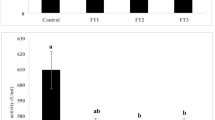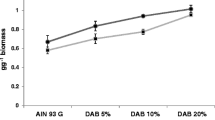Abstract
A simple method for spiking formulated feed with domoic acid (DA) was developed in this study. DA feed was prepared by mixing 0.15 mL 100 μg mL−1 DA with 0.1 g formulated feed, and drying the mixture at room temperature for 2h. The prepared DA feed contained 0.19 pg DA per particle. Of the added DA, 46.72% was retained in the feed. Relatively high DA retention (about 50%) was recorded after DA feed was soaked in water for 2h. Exposure to DA feed for 7 d did not cause the increase of tissue DA level of adult king scallop (Pecten maximus) significantly in 60 d. The increase of their gonad index after DA exposure was not significantly different from the control. No significant change in DA level was found in spermary, ovary or fertilized eggs after DA exposure. These results indicated that DA excretion may be more efficient than DA accumulation under the current experimental conditions, and the mechanism of domoic acid incorporation in P. maximus may involve intracellular biotransformation.
Similar content being viewed by others
References
Arévalo, F. F., M. Bermúdez, and C. Salgado, 1998. ASP toxicity in scallops: individual variability and tissue distribution. In: Harmful Algae. Reguera, B., et al., eds, Xunta de Galicia and the IOC of UNESCO, Paris, 499–502.
Bargu, S., B. Marinovic, S. Mansergh, and M.W. Silver, 2003. Feeding response of krill to the toxin-producing diatom Pseudo-nitzschia. J. Exp. Mar. Biol. Ecol., 284: 87–104.
Bates, S. S., C. J. Bird, A. S. W. de Freitas, R. Foxall, M. Gilgan, et al., 1989. Pennate diatom Nitzschia pungens as the primary source of domoic acid, a toxin in shellfish from eastern Prince Edward Island, Canada. Can. J. Fish. Aquat. Sci., 46: 1203–1215.
Bates, S. S., D. L. Garrison, and R. A. Horner, 1998. Bloom dynamics and physiology of domic acid producing Pseudonitzschia species. In: Physiological Ecology of Harmful Algal Blooms. Anderson, D.M., et al., eds., Springer-Verlag Berlin, Heidelberg, Germany, 267–292.
Biosense Laboratories, 2005. ASP ELISA Kit for Quantitative Determination of Domoic Acid in Shellfish (Method Protocol). Bergen Biosense AS, Bergen, Norway, 9–12.
Blanco, J., C. P. Acosta, M. B. Puente, and C. Salgado, 2002. Depuration and anatomical distribution of the amnesic shellfish poisoning (ASP) toxin domoic acid in the king scallop Pecten maximus. Aquat. Toxicol., 60: 111–121.
Bricelj, V. M., J. H. Lee, A. D. Cembella, and D. A. Anderson, 1990. Uptake kinetics of paralytic shellfish toxins from the dinoflagellate Alexandrium fundyense in the mussel Mytilus edulis. Mar. Ecol. Prog. Ser., 63: 177–188.
Bricelj V. M., J. H. Lee, and A. D. Cembella, 1991. Influence of dinoflagellate cell toxicity on uptake and loss of paralytic shellfish toxins in the northern quahog Mercenaria mercenaria. Mar. Ecol. Prog. Ser., 74: 33–46.
Campbell, D. A., M. S. Kelly, M. Busman, C. J. Bolch, E. Wiggins, et al., 2001. Amnesic shellfish poisoning in the king scallop, Pecten maximus, from the west coast of Scotland. J. Shellfish Res., 20(1): 75–84.
Cousins, S. J., 2005. Amnesic shellfish poisoning and the king scallop, Pecten maximus. Th. D. Thesis. University of Dundee and FRS Marine Laboratory, UK, 128–153.
Cusack, C. K., S. S. Bates, M. A. Quilliam, J. W. Patchin, and R. Raine, 2002. Confirmation of domoic acid production by Pseudo-nitzschia australis (Bacillariophyceae) isolated from Irish waters. J. Phycol., 38(6): 1106–1112.
Davidovich, N. A., and S. S. Bates, 1998. Sexual reproduction in the pinnate diatoms Pseudo-nitzschia multiseries and P. pseudodelicatissima (Bacillariophyceae). J. Phycol., 34: 126–137.
Devauchelle, N., and C. Mingant, 1991. Review of the reproductive physiology of the scallop, Pecten maximus, applicable to intensive aquaculture. Aquat. Living Resour., 4: 41–51.
Douglas, D. J., E. R. Kenchington, C. J. Bird, R. Pocklington, B. Bradford, et al., 1997. Accumulation of domic acid by the sea scallop (Placopecten magellanicus) fed cultured cells of toxic Pseudo-nitzschia multiseries. Can. J. Fish. Aquat. Sci., 54: 907–913.
Fast, M. D., A. D. Cembella, and N. W. Ross, 2006. In vitro transformation of paralytic shellfish toxins in the clams Mya arenaria and Protothaca staminea. Harmful Algae, 5: 79–90.
Fehling, J., K. Davidson, C. J. Bolch, and S. S. Bates, 2004. Growth and domoic acid production by Pseudo-nitzschia seriata (Bacillariophyceae) under phosphate and silicate limitation. J. Phycol., 40(4): 622–630.
Jones, T. O., J. N. C. Whyte, L. D. Townsend, N. G. Ginther, and G. K. Iwama, 1995a. Effects of domoic acid on haemolymph pH, PCO2 and PO2 in the Pacific oyster, Crassostrea gigas and the California mussel, Mytilus californianus. Aquat. Toxicol., 31: 43–55.
Jones, T. O., J. N. C. Whyte, N. G. Ginther, L. D. Townsend, and G. K. Iwama, 1995b. Haemocyte changes in the Pacific oyster, Crassostrea gigas, caused by exposure to domoic acid in the diatom Pseudonitzschia pungens f. multiseries. Toxicon, 33(3): 347–353.
Kleivdal, H., 2004. ASP Direct c ELISA Method Development and Single Laboratory Validation—Method Validation Report. Biosense laboratories AS, Bergen, Norway, 18–19.
Lawrence, J. F, C. F. Charbonneau, and C. Menard, 1991a. Liquid chromatographic determination of domoic acid in mussels, using the AOAC paralytic shellfish poison extraction procedure: Collaborative study. J. Assoc. Off. Anal. Chem., 74: 68–72.
Lawrence, J. F., and C. Menard, 1991b. Determination of marine biotoxins by liquid chromatography. J. Anal. Chem., 339: 494–498.
Lawrence, J. F., C. Cleroux, and J. F. Truelove, 1994. Comparisons of high performance liquid chromatography with radioimmunoassay for the determination of domoic acid in biological samples. J. Chromatogr., 662: 173–177.
Liu, H., M. S. Kelly, D. A. Campbell, S. L. Dong, J. X. Zhu, et al., 2007. Exposure to domoic acid affects larval development of king scallop Pecten maximus (Linnaeus, 1758). Aquat. Toxicol., 81: 152–158.
Maneiro, I., P. Iglesias, D. Guisande, I. Riveiro, A. Barreiro, et al., 2005. Fate of domoic acid ingested by the copepod Acartia clausi. Mar. Biol., 148(1): 123–130.
Millican, P. F., 1997. The Hatchery Rearing of King Scallop (Pecten maximus). The centre for Environment, Fisheries & Aquaculture Science (SEFAS), UK, 40pp.
Novaczek, I., M. S. Madhyastha, R. F. Ablett, G. Johnson, M. S. Nijjar, et al., 1991. Uptake, disposition and depuration of domoic acid by blue mussels (Mytilus edulis). Aquat. Toxicol., 21: 103–118.
Quilliam, M. A., M. Xie, and W. R. Hardstaff, 1995. Rapid extraction and cleanup for liquid chromatographic determination of Domoic acid in unsalted seafood. J. Asso. Off. Anal. Chem. Int., 78: 543–554.
Parker, R. S., and D. P. Selivonchick, 1986. Uptake and metabolism of lipid vesicles from seawater by juvenile Pacific oysters (Crassostrea gigas). Aquaculture, 53: 215–228.
Shumway, S. E., 1990. A review of the effects of algal blooms on shellfish aquaculture. J. World Aqua. Soc., 21: 65–104.
Todd, E. C. D., 1993. Amnesic shellfish poisoning — a review. J. Food Prot., 56: 69–83.
Wright, J. L. C., and M. A. Quilliam, 1995. Methods for domoic acid, the amnesic shellfish poisons. In: IOC Manual on Harmful Marine Algae, IOC Manuals and Guides 33. Hallegraeff, G.M., et al., eds., UNESCO, Paris, 113–133.
Author information
Authors and Affiliations
Corresponding author
Rights and permissions
About this article
Cite this article
Liu, H., Kelly, M.S., Campbell, D.A. et al. Ingestion of domoic acid and its impact on king scallop (Pecten maximus, Linnaeus 1758). J Ocean Univ. China 6, 175–181 (2007). https://doi.org/10.1007/s11802-007-0175-6
Received:
Accepted:
Issue Date:
DOI: https://doi.org/10.1007/s11802-007-0175-6




